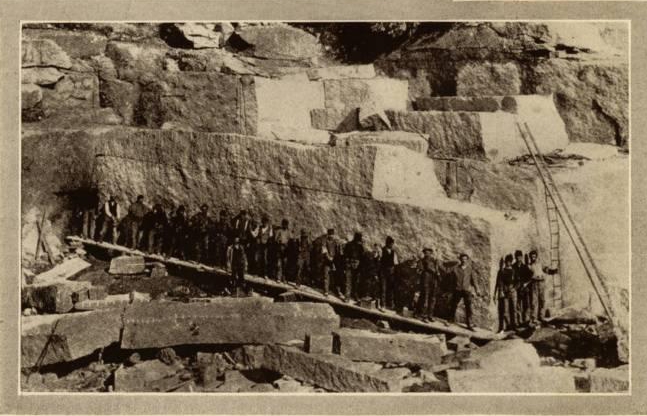Benjamin Green opened Branford’s first quarry in 1858. The unusual pink granite found at the Stony Creek site in Branford brought in numerous competitors, and in less than 50 years the multiple quarries in the area employed approximately 1,800 men. Recognized for its superior quality, the polished rock that came out of Branford traveled by schooner or rail to points as far as Chicago and New Orleans and made up significant portions of such prestigious structures as the Battle Monument at West Point, the George Washington Bridge, and the buildings of the Smithsonian Institute.
Industry’s Success and the Railroad Transform Community
During the local industry’s boom time—the years leading up to 1900—quarrying in Branford radically altered the development of the town. The arrival of the railroad in 1852 brought in ever-greater labor supplies and provided reliable transportation for finished products. Quarry workers from Italy, Ireland, Sweden, Finland, and Spain needed housing, provisions, and schools for their children. Branford developed into a bustling community with grocery stores, two dry goods stores, a blacksmith shop, two barbershops, a shoe store, a druggist, and nine saloons. The stretch of granite that made up the Stony Creek vein eventually gave rise to three competitors that dominated the local industry: Norcross Brothers and the Stony Creek Red Granite Company in Branford, as well as the Beattie Quarry in nearby Guilford.
The Beattie Quarry is perhaps most famous for providing the granite used in the base of the Statue of Liberty. John Beattie, a Scottish immigrant and son of a stone cutter, bought 400 acres of land at Leetes Island in 1869. Included in this land was a part of the huge vein of granite that ran into the Stony Creek section of Branford. On August 5, 1884, a 6-ton block of Beattie’s granite became the cornerstone for the Statue of Liberty’s base. At one point, Beattie temporarily ceased his granite shipments for the project due to a lack of payment, but the famous publisher Joseph Pulitzer stepped in and helped raise the funds necessary to pay Beattie for the remainder of the statue’s granite base.
The Red Granite Company, founded in 1876, eventually became the Stony Creek Red Granite Company and furnished the stone for Grant’s Tomb as well as for the post office at Grand Central Station. A stone the company entered in the 1898 Chicago Exposition won second place.

Splitting a block of Stony Creek Granite, Stony Creek, Branford
Norcross Brothers originated in Worcester, Massachusetts. The company bought property in Stony Creek in 1887 and became the most successful operation in the area. The company’s ability to produce large, seamless stones earned it a contract to provide granite for the West Point Monument. The piece it provided was 20-feet square and 50-feet long and did not contain a single crack. Almost one hundred years later, operating under the name Castelluci & Sons, the company provided the stone for New York City’s famous AT&T (now Sony), building. Completed in 1984, this project alone earned the company an estimated $8 million.
Today, local quarrying operations are largely consolidated under the auspices of the Stony Creek Quarry Corporation. Still located in Branford, the company employs more modern, efficient, and cost-effective quarrying techniques to provide stone for commercial, residential, and municipal projects.









